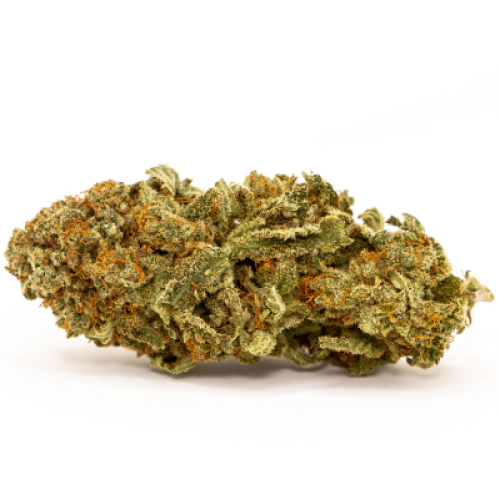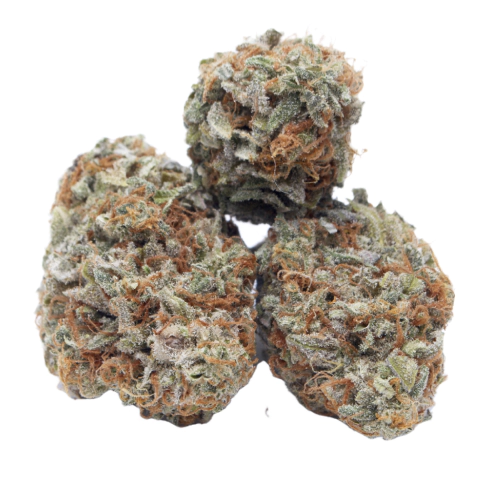
THC 15.5 - 18%
CBD 0.77 - 0.98%
Effect Happy
Flavor Pine
17.25 - 20%
0.16 - 0.49%
0.43 - 1.54%
Berry, Grape
Relaxed
The Purple Candy strain is an Indica-dominant hybrid with a 70/30 ratio of Indica and Sativa in its composition. However, the Indica character dominates in its effects. The THC content averages around 17-20%, so it's a good choice for both novice smokers who want to relax and veteran tokers looking to plunge into the peaceful bliss. Purple Candy weed has interesting genetics. It's a cross between Mendocino Purps and BC Sweet Tooth, and it has Afghani, Nepalese, and Hawaiian roots in its genetics.
I love the colorful look, a unique combo of purple, amber and green sheltered by glittering trichomes. The smell of roses make me hooked and the taste of honey keeps me coming back. Look how Im behaving, happyy and euphoric.
True to its name, this weed has a candy-like taste. It also carries a recognizable mixture of woody and pine notes, accentuated by an amazing fruit aroma of berries and grapes that can make your mouth water right after the first puff. The smoke from it is palatable and not overwhelming, so you can safely combust it in public without worrying about drawing too much attention to yourself.
This high is relatively slow, and it usually takes up to a few minutes before the weed makes its presence known after it has been toked. As a rule, the effect reveals itself with light pressure around the area of your temples and then spreads further throughout your body, distorting the sense of time. Most often than not, this is the moment when users feel uplifted and have an incredible boost in productivity, which makes it easier for them to concentrate on work or creative projects. Over time, this effect points itself towards physical relaxation, where all you want is to just kick back and relax. Due to these properties, this cannabis is best used on those days when you’ve got no specific plans.
Just like most other strains, Purple Candy is known for its versatile effect, allowing it to be used not only for pure enjoyment but also for treating medical cannabis patients diagnosed with:
That being said, it’s worth noting that if a dosage’s been increased, the marijuana can leave you couchlocked, squelching any motivation to get out of your bed and do a thing.
The Purple Candy weed strain is moderately easy to grow, as it requires to be cultivated either in a greenhouse or in a semi-humid climate with temperatures between 70-80 Fahrenheit. On the other hand, you won’t find any difficulty finding its seeds — they can be purchased online from any retailer. On average, the flowering time of this weed takes about 8-9 weeks, while the harvest time comes in 72 days. Whether you grow it indoors or out, the plant can reach up to 80 inches high, meaning it needs to be pruned occasionally to keep it growing healthily.
| THC | Tetrahydrocannabinol, or THC, is a major cannabis chemical compound. It is a psychoactive element that stimulates dopamine release and induces euphoria or happiness. THC-rich strains may be helpful with such conditions as lack of appetite, chronic pains , etc. It is considered to be the primary active marijuana component. | 17.25 - 20% |
| CBD | Cannabidiol, or CBD, is a major compound in cannabis, which is non-psychoactive. It is also proved to counteract the side effects of the second major component THC. CBD is widely used for medicinal purposes in rubs, oils and so on. It is helpful in muscle pain cases, may treat arthritis and migraines. Even Greeks used it against pain, while Queen Victoria applied it to get rid of menstrual cramps. | 0.16 - 0.49% |
| CBC | Cannabichromene, or CBC, is a minor cannabinoid, meaning that its quantity in cannabis is quite little. Though it has the same origin as CBD and THC, it is different in functions. Without any psychoactive effects, it is an efficient cannabis compound in combating acne and depression. CBC produces analgesic, antibacterial and anti-inflammatory effects. | 0.24 - 0.97% |
| CBG | Cannabigerol, or CBG, is one of the minor cannabis compounds in adult plants. On the other hand, young ones contain a lot of this antibacterial and anti-inflammatory component. During the growth, CBG is converted into different cannabinoids, mostly THC and CBD. The compound itself increases appetite and decreases eye pressure. | 0.43 - 1.54% |
| CBN | Cannabinol, or CBN, is a trace element in cannabis that is considered to be mildly psychoactive. It appears from oxidation THC, exposed to light and heat. CBN is mostly contained in old cannabis and in traditional hashish. It is effective against insomnia, bacterial infections and appetite loss. | 0.28 - 0.4% |
| THCV | Tetrahydrocannabivarin, or THC-V, is a compound contained in cannabis in trace amounts. Even though it is close to THC molecularly, it is different in effects. This compound may be psychoactive only in large amounts. THC-V reduces blood sugar, controls appetite, stimulates bone growth, etc. African Sativa strains are the richest in THC-V. | 0.18 - 0.72% |
| Carene | Carene (also known as Delta-3 carene) is a terpene found in rosemary, lemons, pines, and cedars, offering citrusy and cypress aroma. Studies on mice showed that carene provides anti-inflammatory effects, as well as promotes bone health and chronic pain relief. | 0.11% |
| Pinene | Pinene is one of the most widespread terpenes in nature, found in pine trees, basil, nutmeg, parsley, and rosemary. Cannabis containing terpene (alpha-pinene or α-pinene) boasts a strong pine scent. Pinene is responsible for anti-inflammatory, pain-relieving, and anti-anxiety effects. | 0.12% |
| Myrcene | Myrcene (also known as β-myrcene) is one of the most common terpenes found in cannabis, representing more than 20% of the modern marijuana terpene profile. Myrcene has a distinct earthy, musky flavor, resembling cloves. It is responsible for calming and soothing effects of weed. Myrcene is also found in hops, thyme, mango, lemongrass, guava melon. | 0.16% |
| Ocimene | Ocimene (derived from the Ancient Greek word Ocimum meaning basil) is a terpene with sweet and herbaceous flavors, also boasting citrusy and woody undertones. Naturally, ocimene occurs in mint, parsley, orchids, hops, kumquats, mangoes, basil, bergamot, lavender, and pepper. Offers antifungal, anti-inflammatory, and antiviral properties. | 0.01% |
| Humulene | Humulene (also known as α-humulene) is one of the major terpenes found in cannabis, contributing to woody, earthy, spicy, herbaceous, and, mainly, floral aromas of cannabis. Used in modern medicine, humulene offers anti-inflammatory, antibacterial, and appetite suppressant effects, which have been well-researched by pharmaceutical companies. | 0.05% |
| Limonene | Limonene (also known as d-limonene) is the second most common terpene in nature and the third most common terpene in cannabis. It has a powerful citrus aroma and can be found in all citruses, including lemons, oranges, grapefruits, limes, juniper, etc. Limonene is known to elevate moods and provide anxiety, depression, and stress relief. | 0.04% |
| Linalool | Linalool (also known as beta linalool, linalyl alcohol, linaloyl oxide, and p-linalool) is one of the rarest terpenes found in cannabis, mostly in small quantities. Linalool is known for its spicy and lavender aroma, bringing relaxation and calming effects. It is also said to provide anti-inflammatory and analgesic properties that can be useful for athletes. | 0.11% |
| Bisabolol | Bisabolol (also known as α-Bisabolol or levomenol) is a lesser-known terpene found in cannabis. It contributes to anti-inflammatory, anti-irritant, antioxidant, anti-microbial, and analgesic properties of weed strains containing bisanol. Attentive smokers would be able to catch a nutty, fruity scent with herbal and floral undertones, with a tender trace of coconut. | 0.04% |
| Phellandrene | Phellandrene (also known as alpha- and beta-phellandrene) is one of the rare terpenes found in cannabis with antihyperalgesic and antidepressive properties. Phellandrene contributes to a minty, woody, and mildly citrus aroma in cannabis. Previously confused with limonene and pinene, phellandrene was eventually distinguished as a separate terpene common for eucalyptus. Also, it could be found in mint, dill, black pepper, cinnamon, parsley, pine, and lavender. | 0.21% |
| Caryophyllene | Caryophyllene (also known as beta or b caryophyllene) is a terpene found in many herbs and spices, such as black pepper, basil, rosemary, and oregano. Cannabis high in caryophyllene delivers a strong spicy, peppery aroma, resembling cinnamon and cloves. Caryophyllene offers potent anti-inflammatory and sedative effects. | 0.16% |
| Total terpenes content | 1.01% |

THC 15.5 - 18%
CBD 0.77 - 0.98%
Effect Happy
Flavor Pine
THC 17.33 - 19.33%
CBD 0.78 - 1.17%
Effect Sleepy
Flavor Pine
THC 22 - 22%
CBD 1.09 - 1.36%
Effect Happy
Flavor Diesel
THC 20 - 23%
CBD 0.66 - 0.79%
Effect Happy
Flavor Butter
THC 19.5 - 20%
CBD 0.77 - 1.04%
Effect Relaxed
Flavor Citrus

THC 16 - 16.5%
CBD 1.02 - 1.23%
Effect Euphoric
Flavor Berry
THC 21 - 22.33%
CBD 0.61 - 1.12%
Effect Happy
Flavor Spicyherbal

THC 21.25 - 22.75%
CBD 0.18 - 0.53%
Effect Happy
Flavor Citrus
THC 18 - 20.25%
CBD 0.57 - 0.86%
Effect Relaxed
Flavor Woody

THC 20.67 - 23.67%
CBD 0.21 - 0.42%
Effect Sleepy
Flavor Grape
THC 20 - 21.5%
CBD 0.75 - 1.12%
Effect Euphoric
Flavor Grape

THC 18.25 - 21.5%
CBD 0.7 - 1.06%
Effect Sleepy
Flavor Berry
THC 10.76 - 15.1%
CBD 0.02 - 0.29%
Effect Uplifted
Flavor Grapefruit
THC 15.8 - 19.6%
CBD 0.46 - 0.74%
Effect Sleepy
Flavor Citrus

THC 21 - 24%
CBD 0.36 - 0.74%
Effect Relaxed
Flavor Citrus
THC 26 - 29.67%
CBD 0.82 - 1.17%
Effect Uplifted
Flavor Lemon
THC 14.67 - 19.17%
CBD 0.31 - 0.66%
Effect Relaxed
Flavor Lemon
THC 16.5 - 19%
CBD 0.27 - 0.44%
Effect Tingly
Flavor Spicyherbal
THC 15.5 - 23%
CBD 0.7 - 1.03%
Effect Euphoric
Flavor Sweet
THC 17 - 19%
CBD 0.31 - 0.44%
Effect Euphoric
Flavor Orange
User Reviews 9
I love the colorful look, a unique combo of purple, amber and green sheltered by glittering trichomes. The smell of roses make me hooked and the taste of honey keeps me coming back. Look how Im behaving, happyy and euphoric.
This is one of those kind of night that the available becomes the desired. I really needed something for my depression and I got Grape valley kush and it was okay but still not on the same level with Purple candy. The smell and taste is still better and brighter.
my group bonged this mj for the better part of Saturday night. It felt good at first but on waking, the headache was bat shit crazy. I could nott not even turn my head without wincing. My movement still not coordinated.
Inability to eat has always been a norm for me, I don’t feel hungry. I just eat little for sustainance but since I started eating these gummy bars, I have been eating more and more recently. I think I have added a few kg.
insomnia is not pretty, everyone is sleeping and all I can do is toss and turn till about 4am. I wake up unrested and grouchy. I started adding some of this weed in my dinner and I manage about 4-5hours of sleep.
It is very useless to use in the day as it makes me lazy and couch locked.
I feel so happy and I don’t get tired of talking and making sensible contributions.
pleasant to smoke
easy and relaxing high
Write a Review